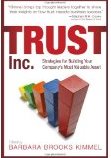Posts
Integrity: What’s Up With That?
Integrity, like trust, is something we all talk about, meaning many different things – but always assuming that everyone else means precisely the same that we do. That leads to vagueness and confusion at best – and angered accusations at worst. Particularly in this time of elections, a careful examination of how we use the words in common language is useful.
Integrity and the Dictionary
Merriam Webster says it’s “the quality of being honest and fair,” and/or “the state of being complete or whole.”
If you’re into derivations of words (as I am), then it’s the second of these definitions that rings true. The root of “integrity” is Latin, integer. That suggests the heart of the matter (integral), and an entirety. “Integer” also has the sense of a non-fractional number, i.e. whole, not fragmented, complete.
In manufacturing, we have the idea of “surface integrity,” the effect that a machined surface has on the performance of the product in question: integrity here means keeping a package of specified performance levels intact. Similarly, a high-integrity steel beam is one that will not break or otherwise become compromised within certain parameters of stress.
Related also to this theme of wholeness is the idea of transparency, of things being whole, complete, not hidden – in this sense, we have high integrity to the extent we appear the same way to all people. Think of the phrase “two-faced” as an example of someone without integrity. (For a somewhat different and nuanced take on this issue in cyberspace, see @danahboyd on Mark Zuckerberg and multiple online identities).
Sometimes when we say someone has integrity, we mean they act consistently, in accord with principles. We say someone has high integrity when they stick to their guns, even in the face of resistance or difficulty.
Which raises an interesting question: where’s the line between integrity and obstinacy? For that matter, can a politician who believes passionately in the art of compromise ever be considered to have high integrity?
Then there’s that other common use of integrity that has a moral overtone – honorable, honest, upright, virtuous, and decent. Some of it has to do with truth-telling; but some of it has to do with pursuing a moral code.
Yet that raises another interesting question: can a gang member or a mafioso be considered to have integrity? Can an Occupy person ever consider a Wall Streeter to have integrity? Or vice versa? There may be honor among thieves, but can there be integrity?
Integrity – Your Choice?
So which is it? Does integrity mean you tell the truth? Does it mean you operate from values? Does it mean you always keep your word? Does it mean you live a moral life? Does it mean your life is an open book?
Let’s be clear: there is no “right” answer. Words like “integrity” mean whatever we choose to make them mean; there is no objective “meaning” that exists in a way that can be arbitrated.
But that makes it even more important that we be clear about what we do mean. It just helps in communication.
For my part, I’m going to use “integrity” mainly to mean whole, complete, transparent, evident-to-all, untainted, what-you-see-is-what-you-get.
For other common meanings of “integrity,” I’m going to stick with synonyms like credible or honest; or moral and upright; or consistent.
What do you mean when you think of integrity?
A Better New Year’s Resolution
It’s that time of year again. Resolutions come in full swing and we all start to assess how we can improve on the last year. It just so happens that I wrote a pretty good blog post at this time eight years ago, and I haven’t improved on it yet. Here it is again.
—————–
My unscientific sampling says many people make New Years resolutions, but few follow through. Net result—unhappiness.
It doesn’t have to be that way.
You could, of course, just try harder, stiffen your resolve, etc. But you’ve been there, tried that.
You could also ditch the whole idea and just stop making resolutions. Avoid goal-failure by eliminating goal-setting. Effective, but at the cost of giving up on aspirations.
I heard another idea: replace the New Year’s Resolution List with a New Year’s Gratitude List. Here’s why it makes sense.
First, most resolutions are about self-improvement—this year I resolve to: quit smoking, lose weight, cut the gossip, drink less, exercise more, and so on.
All those resolutions are rooted in a dissatisfaction with the current state of affairs—or with oneself.
In other words: resolutions often have a component of dissatisfaction with self. For many, it isn’t just dissatisfaction—it’s self-hatred. And the stronger the loathing of self, the stronger the resolutions—and the more they hurt when they go unfulfilled. It can be a very vicious circle.
Second, happy people do better. This has some verification in science, and it’s a common point of view in religion and psychology—and in common sense.
People who are slightly optimistic do better in life. People who are happy are more attractive to other people. In a very real sense, you empower what you fear—and attract what you put out.
Ergo, replace resolutions with gratitude. The best way to improve oneself is paradoxical—start by being grateful for what you already have. That turns your aspirations from negative (fixing a bad situation) to positive (making a fine situation even better).
Gratitude forces our attention outwards, to others—a common recommendation of almost all spiritual programs.
Finally, gratitude calms us. We worry less. We don’t obsess. We attract others by our calm, which makes our lives connected and meaningful. And before long, we tend to smoke less, drink less, exercise more, gossip less, and so on. Which of course is what we thought we wanted in the first place.
But the real truth is—it wasn’t the resolutions we wanted in the first place. It was the peace that comes with gratitude. We mistook cause for effect.
Go for an attitude of gratitude. The rest are positive side-effects.
A Better New Year’s Resolution
Happy New Year!  I wrote a good blog post at this time seven years ago, and haven’t improved on it yet. Here it is again.
I wrote a good blog post at this time seven years ago, and haven’t improved on it yet. Here it is again.
Happy New Year.
—————–
My unscientific sampling says many people make New Years resolutions, but few follow through. Net result—unhappiness.
It doesn’t have to be that way.
You could, of course, just try harder, stiffen your resolve, etc. But you’ve been there, tried that.
You could also ditch the whole idea and just stop making resolutions. Avoid goal-failure by eliminating goal-setting. Effective, but at the cost of giving up on aspirations.
I heard another idea: replace the New Year’s Resolution List with a New Year’s Gratitude List. Here’s why it makes sense.
First, most resolutions are about self-improvement—this year I resolve to: quit smoking, lose weight, cut the gossip, drink less, exercise more, and so on.
All those resolutions are rooted in a dissatisfaction with the current state of affairs—or with oneself.
In other words: resolutions often have a component of dissatisfaction with self. For many, it isn’t just dissatisfaction—it’s self-hatred. And the stronger the loathing of self, the stronger the resolutions—and the more they hurt when they go unfulfilled. It can be a very vicious circle.
Second, happy people do better. This has some verification in science, and it’s a common point of view in religion and psychology—and in common sense.
People who are slightly optimistic do better in life. People who are happy are more attractive to other people. In a very real sense, you empower what you fear—and attract what you put out.
Ergo, replace resolutions with gratitude. The best way to improve oneself is paradoxical—start by being grateful for what you already have. That turns your aspirations from negative (fixing a bad situation) to positive (making a fine situation even better).
Gratitude forces our attention outwards, to others—a common recommendation of almost all spiritual programs.
Finally, gratitude calms us. We worry less. We don’t obsess. We attract others by our calm, which makes our lives connected and meaningful. And before long, we tend to smoke less, drink less, exercise more, gossip less, and so on. Which of course is what we thought we wanted in the first place.
But the real truth is—it wasn’t the resolutions we wanted in the first place. It was the peace that comes with gratitude. We mistook cause for effect.
Go for an attitude of gratitude. The rest are positive side-effects.
Trust Inc.: Strategies for Building the Trust Asset – Chapter 1
 This is an abridged version of the opening chapter – “The Business Case for Trust” – of the just-published Trust, Inc.: Strategies for Building Your Company’s Most Value Asset.
This is an abridged version of the opening chapter – “The Business Case for Trust” – of the just-published Trust, Inc.: Strategies for Building Your Company’s Most Value Asset.
The book is a collection of 30-plus articles by diverse authors on trust in business. Edited by Barbara Kimmel of Trust Across America, the book covers issues ranging from measuring trust, diagnosing its presence or absence, managing trust and increasing trustworthiness, to improving people, companies, industries and societies.
Barbara and I co-authored the opening chapter. Other authors in the book include names like Steven M.R. Covey Jr., Ken Blanchard, James Kouzes and Barry Posner, Peter Firestein (investor relations), Laura Rittenhouse (financial candor), Jim Gregory (branding), and Linda Locke (reputation). And more.
Have a taste of the book, below. And click through here to see a complete table of contents and authors list. Whatever your interest in business in trust, you’ll find something here the addresses it.
The Business Case for Trust
by Barbara Brooks Kimmel and Charles H. Green: from Chapter 1 of Trust, Inc.,publisher Next Decade, November 2013.
Trustworthiness — once exemplified by a simple firm handshake — is a business value that has suffered erosion. We see this in how the public has grown increasingly cynical about corporate behavior—with good reason.
The PR firm Edelman found in a recent “Trust Barometer” survey that trust, transparency, and honest business practices influence corporate reputation more than the quality of products and services or financial performance. And yet, scandals and bad behavior continue to pile up.
Our view is that a company seriously interested in its reputation must increasingly focus not just on “business performance” as it is traditionally understood, but on being seen as trustworthy too.
We believe there is an important, material business case for trust. This doesn’t mean that trust isn’t or shouldn’t be justified on moral or societal grounds. Of course it should. But trust makes for good business as well. This essay will put forth the business case for trust by exploring the gap between low- and high-trust organizations’ performance. We will also offer a framework for assessing corporate trustworthiness, and point the way toward strategies for creating a trust-enhancing business model.
First, let’s look at the costs of low trust.
How low trust affects stakeholder outcomes
Low Trust in Society
Business operates in a social context; because of that, low trust in society-at-large costs business. Indirect examples include the TSA airport security program ($5.3 billion, not to mention the impact on tens of millions of business travelers), and the criminal justice system ($167 billion in 2004). Both of these examples are funded by taxes on individuals and business.
Businesses also shoulder direct tangible losses from crime ($105 billion), where they are often the victims.
A more obvious social cost for business is the cost of regulation. Economist Clyde Wayne Crews releases an annual report entitled “The Ten Thousand Commandments” that tallies federal regulations and their costs. In 2010, the federal government spent $55.4 billion dollars funding federal agencies and enforcing existing regulation. In 2013, The Washington Post reported that “the federal government imposed an estimated $216 billion in regulatory costs on the economy (in 2012), nearly double its previous record.”
Doing business in a low-trust environment is costly. Whether or not you believe that companies can, or should directly impact social conditions, one thing is clear. In aggregate, business bears a lot of weight for the cost of low-trust in our society.
Low Trust in Business Practices
Social costs on business, however, are just the tip of the iceberg. Far bigger costs are exacted by simple business practices. Consider the
need for detailed financial audits. The Big 4 accounting firms’ aggregate global revenue is $110 billion5, of which about one quarter is made up of audits in the U.S.
Consider lawyers: there are over 1.2 million licensed attorneys in the United States, more per capita than in 28 of 29 countries (Greece being the 29th). The cost of the tort litigation system alone in the United States is over $250 billion—or 2% of GDP. It’s estimated that tort reform in health care alone could trim medical costs by 27 percent.
All these are examples of transaction costs: costs we incur to protect or gain (we hope) larger economies of scale, markets, or hierarchies. Transaction costs add no value to the economy per se; they just foster favorable market conditions so that other economic factors (e.g. markets, scale economies) can add value.
But there comes a point at which the addition of more non-value-adding transaction costs ceases to be positive and becomes burdensome. It’s clear to us today that we are well past this point. A Harvard Business Review article from 8 years ago (Collaboration Rules by Philip Evans and Bob Wolf, July 2005) suggests that nearly 50% of the U.S. non-governmental GDP was, as of 2005, comprised of transaction costs. Imagine the impact of redirecting even a small proportion of these monies to value-adding actions.
Their research goes on to say that, in such an economy, the most productive investments are often not those that increase scale or volume, but those that reduce transaction costs. And the most viable strategy for reducing massive transaction costs? Trust.
Low Trust and Employee Disengagement
Disengagement occurs when people put in just enough effort to avoid getting fired but don’t contribute their talent, creativity, energy or passion. In economic terms, they under-perform. Gallup’s research places 71 percent of U.S. workers as either not engaged or actively disengaged. The price tag of disengagement is $350 billion a year. That roughly approximates the annual combined revenue of Apple, General Motors and General Electric.
According to The Economist, 84 percent of senior leaders say disengaged employees are considered one of the biggest threats facing their business. However, only 12 percent of them reported doing anything about this problem.
What does disengagement have to do with trust? Everything. In a Deloitte LLP ethics and workplace survey, the top three reasons given for employees planning to seek a new job were:
- A loss of trust in their employer based on decisions made during the Great Recession (48 percent);
- A lack of transparency in leadership communication (46 percent); and
- Being treated unfairly or unethically by employers over the last 18 to 24 months (40 percent).
A lack of trust in the employer is at the heart of each of these reasons. To the extent that plans to find a new job are a proxy for disengagement, the case is clear. Lack of trust drives away employees.
In discussing the survey, Deloitte LLP Board Chairman Sharon Allen notes:
Regardless of the economic environment, business leaders should be mindful of the significant impact that trust in the workplace and transparent communication can have on talent management and retention strategies. By establishing a values-based culture, organizations can cultivate the trust necessary to reduce turnover and mitigate unethical behavior.
The survey also provides some interesting data on the business case for organizational trust. When asked to rate the top two items most positively affected when an employee trusts his or her employer, employed U.S. adults made the following top rankings:
- Morale (55%);
- Team building and collaboration (39%);
- Productivity and profitability (36%);
- Ethical decision making (35%); and
- Willingness to stay with the company (32%).
As Mary Gentile eloquently states later in this book, “Very often the most visible, most costly challenges to the public trust in business are fairly predictable: deceptive marketing practices; falsified earnings reporting; failure in safety compliance; lack of consistency in employee relations; and so on.”
In other words, the ability to manage the costs of low trust –whether arising from society, from business practices, or from management practices—is to a great extent within the control of the corporation. And yet, it is largely not being done—with sadly predictable results.
Continue reading:
How high trust improves stakeholder outcomes
A framework for assessing trustworthiness
Trustworthiness in Action
Trust, Scale, and the Corporation
 I always have trouble answering a question I’m often asked: What company does a great job on trust? Because the answer is some combination of, “it depends on the definition of trust,” and “hardly any.” Let me unpack that.
I always have trouble answering a question I’m often asked: What company does a great job on trust? Because the answer is some combination of, “it depends on the definition of trust,” and “hardly any.” Let me unpack that.
Trustworthiness and the Corporation
Mitt Romney’s metaphysics notwithstanding, corporations are not people, apart from a few legal rights. Corporations don’t smile, feel guilty, bleed, or feel emotions. That means: it makes some sense to say “company X is trustworthy,” but it makes little sense to say “company X trusts.”
Trustworthiness attributes that a company can exhibit include reliability and transparency. But to say that a company trusts is simply to make statements about company policies put in place by people. So from one perspective, the connection between corporations and trust is largely a subset of trustworthiness.
Of course, from another perspective it’s meaningful nonetheless to talk about corporations in terms of trust. That perspective is best articulated by Trust Across America, which uses the acronym FACTS to identify five metrics associated with trustworthiness. Those are: Financial stability and strength , Accounting conservatism, Corporate integrity, Transparency, and Sustainability. Most people would generally agree that those attributes are associated with what we call trust, and I think TAA have done a sensible job of defining and weighting those components.
And yet, that still leaves all that human-y stuff – the bleeding, feeling, risk-taking, emotional parts of trust. The parts that corporations can’t do.
Personal Trust in the Corporation
Corporations cannot trust, but they have enormous effects on whether or not its people trust, and are trustworthy. The biggest influence on trustworthiness and the propensity to trust is not metrics, or compensation systems, or even policies. It is values and culture. Do the values and culture celebrate honesty, integrity, long-term perspectives, and other-orientation? Or do they stress short-term performance, micro-metrics, “being tough,” and meeting the numbers?
The question of values and culture brings me back to that opening question: What company does a great job on trust?
When I answer “hardly any,” what I’m saying is I don’t see any large corporations that are driven by trust-related values, or support trust-friendly cultures. I have seen some good examples of smaller-scale organizations that are highly trust-based – a unit at Microsoft, Bangor Savings Bank, and Pediatric Services of America, for example But these are relatively small organizations. Where are the Citibanks, General Motors and Oracles in the pantheon of trust-friendly organizations? Is the problem that trust can’t scale?
Can Trust Scale?
Trust very much can scale. In fact, values-driven organizations scale very well, especially in fast-moving and complex industries, where standardized processes are too complex to keep up with reality. The issue is not being values-driven – the issue is which values will drive. Goldman Sachs is a values-driven organization; so is Apple. It’s just that the values being valued don’t include trust in the top list.
Now here I’ll get speculative. I think this is because the dominant values in Western business in the last 50 years have been largely anti-trust. The values we have espoused have included competition, the Darwinian-revised version of Adam Smith’s Invisible Hand, caveat emptor, management-by-metrics, management-by-process, and the reduction of all issues to an NPV calculation.
These are serious values, and they are all either anti-trust or trust-neutral (even though, as Trust Across America is demonstrating, trust is associated with higher profitability). And they are extremely dominant values. You don’t get to be a Big Corporation without drinking deeply of these belief systems, taught as they are in MBA programs and the popular business press.
A significant part of building trust in business is going to come not by revising policies and governance, and not by better regulation, but by re-orienting a corporation around core trust values. I see no reason to believe that trust values can’t scale as well as the other values; we’re just awaiting leaders with the vision and courage to lead the way.
A Better New Year’s Resolution
 I wrote a good blog post at this time six years ago, and haven’t improved on it yet. Here it is again.
I wrote a good blog post at this time six years ago, and haven’t improved on it yet. Here it is again.
Happy New Year.
—————–
My unscientific sampling says many people make New Years resolutions, but few follow through. Net result—unhappiness.
It doesn’t have to be that way.
You could, of course, just try harder, stiffen your resolve, etc. But you’ve been there, tried that.
You could also ditch the whole idea and just stop making resolutions. Avoid goal-failure by eliminating goal-setting. Effective, but at the cost of giving up on aspirations.
I heard another idea: replace the New Year’s Resolution List with a New Year’s Gratitude List. Here’s why it makes sense.
First, most resolutions are about self-improvement—this year I resolve to: quit smoking, lose weight, cut the gossip, drink less, exercise more, and so on.
All those resolutions are rooted in a dissatisfaction with the current state of affairs—or with oneself.
In other words: resolutions often have a component of dissatisfaction with self. For many, it isn’t just dissatisfaction—it’s self-hatred. And the stronger the loathing of self, the stronger the resolutions—and the more they hurt when they go unfulfilled. It can be a very vicious circle.
Second, happy people do better. This has some verification in science, and it’s a common point of view in religion and psychology—and in common sense.
People who are slightly optimistic do better in life. People who are happy are more attractive to other people. In a very real sense, you empower what you fear—and attract what you put out.
Ergo, replace resolutions with gratitude. The best way to improve oneself is paradoxical—start by being grateful for what you already have. That turns your aspirations from negative (fixing a bad situation) to positive (making a fine situation even better).
Gratitude forces our attention outwards, to others—a common recommendation of almost all spiritual programs.
Finally, gratitude calms us. We worry less. We don’t obsess. We attract others by our calm, which makes our lives connected and meaningful. And before long, we tend to smoke less, drink less, exercise more, gossip less, and so on. Which of course is what we thought we wanted in the first place.
But the real truth is—it wasn’t the resolutions we wanted in the first place. It was the peace that comes with gratitude. We mistook cause for effect.
Go for an attitude of gratitude. The rest are positive side-effects.
Four Principles of Organizational Trust: How to Make Your Company Trustworthy
This week, as we get ready to say goodbye to 2012, we’re going to be posting some of what we call “Golden Oldies,” great posts from our Trust Matters vault. We hope everyone has a safe and happy holiday and wonderful New Year.
—————————————–
 Trust, in case you hadn’t noticed, has gotten “hot” lately. But much of it sounds very vague—soft, fluffy, nice-to-have, the buzzword du jour.
Trust, in case you hadn’t noticed, has gotten “hot” lately. But much of it sounds very vague—soft, fluffy, nice-to-have, the buzzword du jour.
I’d like to do my part to make it real.
To me, that means breaking it down and making it sound; tapping into the strategy and mysticism, but also staying grounded in the tactical and the practical.
So let’s review some context; then talk about four specific operating principles a business can hone in on to improve its trustworthiness.
Putting Trust into a Workable Context
I’ve suggested elsewhere that “trust” is too vague a term to work with. To do something practical, we need first to identify the trust realm: are we talking about personal trust, or business/organizational trust, or social/institutional trust?
The next question is about the trust role: are we working on being more trusting? Or more trustworthy? They are not the same thing. And “trust” is the result of them both interacting.
Building a Trustworthy Business
In the realm “personal” and the role “trustworthy,” we can point to personal beliefs and behaviors as indicated in the Trust Quotient. But in business, trustworthiness is built through a set of daily operating principles. Trustworthiness is built from habitually behaving in accordance with a set of commonly shared beliefs about how to do business.
I suggest they can be boiled down to four.
The Four Trust Principles
1. A focus on the Other (client, customer, internal co-worker, boss, partner, subordinate) for the Other’s sake, not just as a means to one’s own ends. We often hear “client-focus,” or “customer-centric.” But these are terms all-too-often framed in terms of economic benefit to the person trying to be trusted.
2. A collaborative approach to relationships. Collaboration here means a willingness to work together, creating both joint goals and joint approaches to getting there.
3. A medium to long term relationship perspective, not a short-term transactional focus. Focus on relationships nurtures transactions; but focus on transactions chokes off relationships. The most profitable relationships for both parties are those where multiple transactions over time are assumed in the approach to each transaction.
4. A habit of being transparent in all one’s dealings. Transparency has the great virtue of helping recall who said what to whom. It also increases credibility, and lowers self-orientation, by its willingness to keep no secrets.
Executing on the Trust Principles
What are the tools an organization has at its disposal to make itself more trustworthy? Any good change management consultant can rattle off the usual suspects, but for trustworthiness, the emphasis has to shift somewhat.
The usual change mantra includes a heavy dose of behaviors, metrics and incentives. Some of that works here, but only to a point.
For example, Principle 1, focus on the Other, is contradicted by too much extrinsic incentive aimed at leveraging self-interest–it undercuts focus on the Other. And Principle 3, relationship over transaction, forces metrics and rewards to a far longer timeframe than most change efforts employ.
Another great shibboleth of change is that it must be led from the CEO’s office. But with trust, it ain’t necessarily so. Trustworthiness is a great candidate for infectious disease change strategies; guerrilla trust strategies can work at the individual level, and individual players can lead. Behavior in accord with these principles cannot be coerced; the flipside is, it can be unilaterally engaged in.
The most powerful tools to create a trustworthy organization are things like language, recognition, story-telling, simply paying attention to the arenas where the principles apply—and the will to apply them. Role-modeling helps; some skill-building helps. But most of all, it is the willingness to notice the pervasive opportunities to work in accordance with this simple set of four principles.
Trustworthiness breeds trusting (the reverse is true too); the combination is what leads to trust. Which, by the way, is quite measurable in its impact on the bottom line.
The Fast Track to Partner: An Interview with Charles H. Green
 Across the pond there’s a slew of interesting and driven professionals making strides towards building a stronger foundation for business–one built heavily on ideas of cultivating trust-based relationships and business practices. That group includes, though is not limited to, Ian Brodie, Sonja Jefferson, David Tovey – and Heather Townsend.
Across the pond there’s a slew of interesting and driven professionals making strides towards building a stronger foundation for business–one built heavily on ideas of cultivating trust-based relationships and business practices. That group includes, though is not limited to, Ian Brodie, Sonja Jefferson, David Tovey – and Heather Townsend.
Heather’s just-published book is How to Make Partner and Still Have a Life. She also hosts an insightful audio-based masterclass series entitled, “Fast Track to Partner.”
This interview-based series is full of tips, action items, and stories. If you’re on partner track somewhere, or are wondering whether you want to be, you want to check this out. And I’m not just saying that because in her latest edition, I happen to be the expert interviewee.
Heather and I spoke last week about how to be a trusted advisor.
Listen to the audio version of my Fast Track To Partner interview. Or, if you’re more of the reading type, we’ve included the full transcript of the interview.
Thanks Heather, and best wishes on the book.
